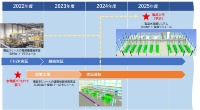Asahi Kasei Demonstrates Hydrogen Production Using Solar and Wind Power, Responds to Output Fluctuations

Appearance image of water electrolysis pilot test facility
(Source: Asahi Kasei)

Positioning of Water Electrolysis Pilot Test Facility
(Source: Asahi Kasei)
Asahi Kasei announced on November 7 that it had begun construction of a pilot test facility for alkaline water electrolysis for hydrogen production at its Kawasaki Plant in Kawasaki City. It is composed of multiple electrolytic cell modules, and it is said that various demonstration experiments such as fluctuation responsiveness and long-term durability are possible.
So far, the company has installed a 10MW class large alkaline water electrolyzer at the Fukushima Hydrogen Energy Research Field (FH2R) in Namie Town, Fukushima Prefecture, as part of a project commissioned by NEDO (New Energy and Industrial Technology Development Organization). . Various tests have been conducted since 2020.
The pilot facility that has started construction this time consists of four electrolytic cell modules with an output of 0.8 MW. The maximum hydrogen production capacity is about 500Nm3/h, which is about one-fourth that of the FH2R.
It is possible to reproduce device behavior in various environments, such as when one module fails during operation or low-output operation assuming nighttime, and it can be used to verify and improve equipment design, operation methods, and control technology. In addition, by designing a device that can simulate output fluctuations of variable renewable energy such as solar and wind power, it is possible to verify the coordination with solar and wind power and the responsiveness as power system adjustment power.
Going forward, the goal is to start operation in early 2024 after construction work, equipment installation, and trial operation. Furthermore, based on the pilot facility and the technological achievements of FH2R, a large-scale alkaline water electrolyzer consisting of multiple 10MW modules will be put on the market by 2025.






